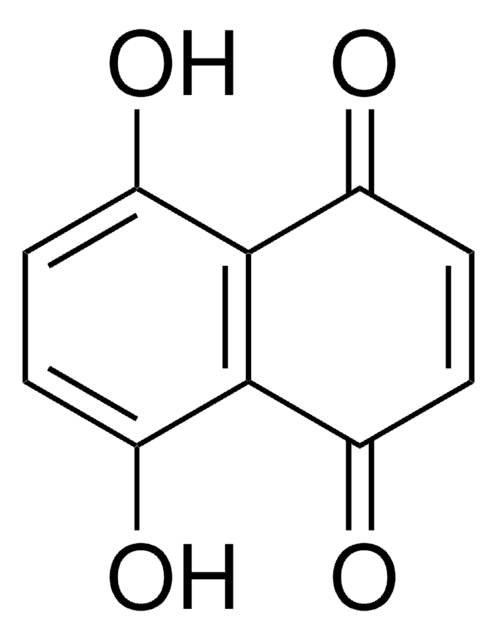420120
Juglone
A highly selective cell-permeable, irreversible inhibitor of PPlases (peptidyl-prolyl cis/trans isomerases of the parvulin family).
Synonyme(s) :
Juglone, 5-Hydroxy-1,4-naphthlenedione, 5-Hydroxy- p-naphthoquinone
About This Item
Produits recommandés
Niveau de qualité
Pureté
≥95% (HPLC)
Forme
solid
Fabricant/nom de marque
Calbiochem®
Conditions de stockage
OK to freeze
protect from light
Couleur
orange
Solubilité
DMSO: 10 mg/mL
ethanol: 10 mg/mL
Conditions d'expédition
ambient
Température de stockage
2-8°C
InChI
1S/C10H6O3/c11-7-4-5-9(13)10-6(7)2-1-3-8(10)12/h1-5,12H
Clé InChI
KQPYUDDGWXQXHS-UHFFFAOYSA-N
Description générale
Actions biochimiques/physiologiques
PPlases (peptidyl-prolyl cis/trans isomerases of the parvulin family)
Conditionnement
Avertissement
Reconstitution
Autres remarques
Hennig, L., et al. 1998. Biochemistry37, 5953.
Informations légales
Mention d'avertissement
Danger
Mentions de danger
Conseils de prudence
Classification des risques
Acute Tox. 3 Oral
Code de la classe de stockage
6.1C - Combustible acute toxic Cat.3 / toxic compounds or compounds which causing chronic effects
Classe de danger pour l'eau (WGK)
WGK 3
Certificats d'analyse (COA)
Recherchez un Certificats d'analyse (COA) en saisissant le numéro de lot du produit. Les numéros de lot figurent sur l'étiquette du produit après les mots "Lot" ou "Batch".
Déjà en possession de ce produit ?
Retrouvez la documentation relative aux produits que vous avez récemment achetés dans la Bibliothèque de documents.
Notre équipe de scientifiques dispose d'une expérience dans tous les secteurs de la recherche, notamment en sciences de la vie, science des matériaux, synthèse chimique, chromatographie, analyse et dans de nombreux autres domaines..
Contacter notre Service technique








